The Persuasive Power of Testimonials (And How to Unlock Them for Your Business)

Think testimonials are just a “nice to have” for your business?
According to the numbers, they might actually be more important to your bottom line than you might expect. Data shows that testimonials are proven to increase conversions and play a major role in customer research and buying habits.
In fact, according to Zendesk, 90% of respondents who read online reviews said that positive reviews influence their buying decisions. Pretty impressive, right?
With this in mind, let’s take a look at how you can improve your customer journey map with the power of social proof via testimonials. We’ll examine exactly how you, too, can source and deploy home-run reviews that drive sales and reduce uncertainty for online shoppers.
Using current customers to validate future buyers
Before we dive into the ‘how’, let’s talk about the ‘why’ of customer testimonials and build a foundation of understanding around the value they provide.
Why customer testimonials work
Testimonials are persuasive because they’re a powerful form of social proof: a psychological concept based around the idea that we are more likely to follow the actions of others before us because we assume that those actions reflect the correct behavior.
Social proof helps you leverage your current customers to sell to potential customers.
Think of it like this: If you see that your favorite beauty icon recommends a certain face cream, you’re going to trust that recommendation, right? Maybe you’ll even buy it. The testimonial instantly validates the product for you.
The same thing happens even if you don’t know the person giving the praise. Testimonials are real, authentic pieces of product feedback that influence purchase decisions.
Research on testimonials: Proof that they work
There have been quite a few studies that look into the effectiveness of testimonials in relation to ROI. The results indicate that they do, in fact, have a major impact on conversions and sales.
The numbers don’t lie:
- Econsultancy data shows that sites showcasing testimonials experience an 18% increase in sales, while increasing the likelihood of purchase for 63% of site visitors.
- When WikiJob tested a site page with testimonials vs. one without, the version with them earned 34% more conversions.
- Reevoo data shows that 50 or more reviews per product can mean a 4.6% increase in conversion rates.
- Brightlocal found that 88% of people trust online reviews written by other consumers as much as they trust recommendations from personal contacts.
What we can take from this is a simple conclusion: Testimonials are essential for ecommerce businesses.
“Customer reviews have been a big help with our organic growth. Instead of advertising, we pour everything we have into delighting our customers—because we believe delighted customers are the best advertising we could ask for. Customer reviews then allow these customers to share their experiences with new visitors to the site. It creates a beautifully positive feedback loop.”
—Jack DuFour, Taaluma Totes
How to gather customer testimonials: the logistics
Now that we understand the value of a testimonial, let’s talk about how you can start collecting your own.
Step one is simple: You need to make the ask.
Data shows that if you ask for a testimonial, most of the time customers are happy to oblige. In fact, a survey by Brightlocal showed that 68% of consumer respondents will leave a review for a business when asked.
So, how do you go about asking for testimonials?
1. Use an automated email that sends 5-7 days after delivery
Gathering reviews doesn’t have to be a manual, time-consuming process. With the help of an automated email that’s triggered to send 5-7 days after delivery, you can reach out to each and every customer and ask them to leave a review if they’re satisfied with the purchase. (Note: You’ll need to integrate Shopify with your ESP or use an app to set up and automate these behavior-triggered emails.)
To encourage action, you might offer a small discount off their next purchase with you, enter them into a drawing for a prize, or even just give them a shoutout on your social media accounts to thank them.
The Stockroom, a store run by members of the Shopify team, took this approach with email outreach during the holiday season and was able to garner 50 reviews in the span of just one week. Here’s one of the automated emails that store owner Mary-Rose Sutton sent out:
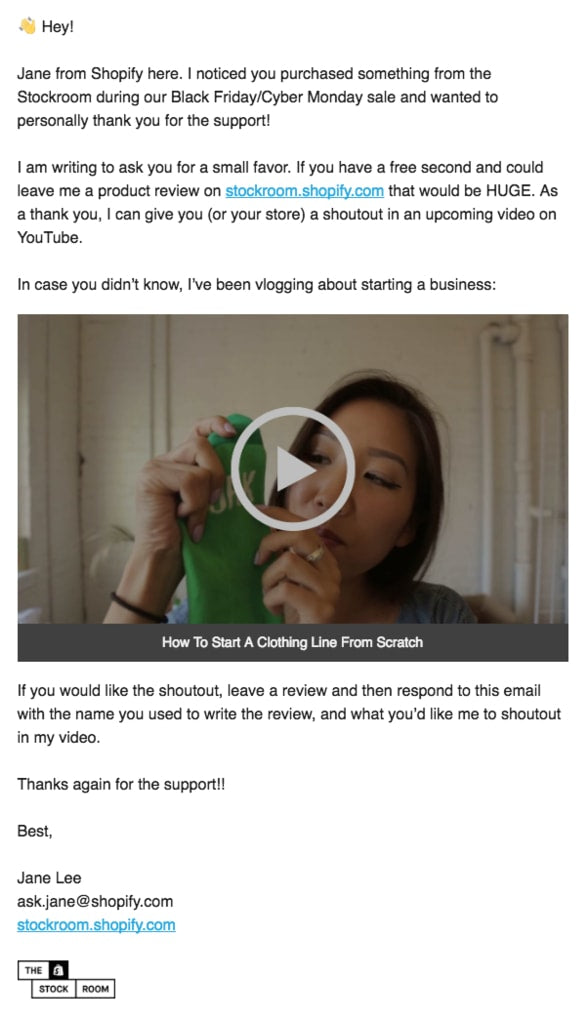
2. Send a customer satisfaction survey
Customer satisfaction surveys are another easy way to gather testimonials and rich customer insights, and you can do this efficiently thanks, again, to email automation. By integrating a tool like SurveyMonkey, you can automatically follow up with customers post-purchase to gather feedback.
Include survey questions like:
- What doubts did you have before completing the purchase?
- What questions did you have prior to purchase?
- Why did you buy [blank]?
- What are you using [blank] for?
By also including an open-ended question that allows participants to write in a testimonial (or to share general thoughts), you can gather social proof all while learning how to improve your customer experience as a whole.
Learn More: What is customer retention and why is it important?
3. Use apps to gather feedback
If you’re looking for a way to integrate a tool that can simplify testimonial collection, consider a few apps that work with Shopify, such as:
All of these integrate seamlessly with your Shopify store and can help you quickly start gathering customer reviews and testimonials.
Who to ask for positive testimonials
High-quality testimonials don’t come from just anyone. Most of the time, they come from a very specific slice of your customer base. Here’s how to find this special group.
Start with your best customers
It only makes sense to kick things off with your best customers—after all, they’re already your biggest fans. If you’re not sure how to find them, consider sorting customers based on conditions, such as:
- Number of purchases: Look for those who’ve repeatedly made purchases from your store
- Total spent: Look for your top-spending customers
- Length of customer relationship: Look for the customers that have had long-term relationships with you
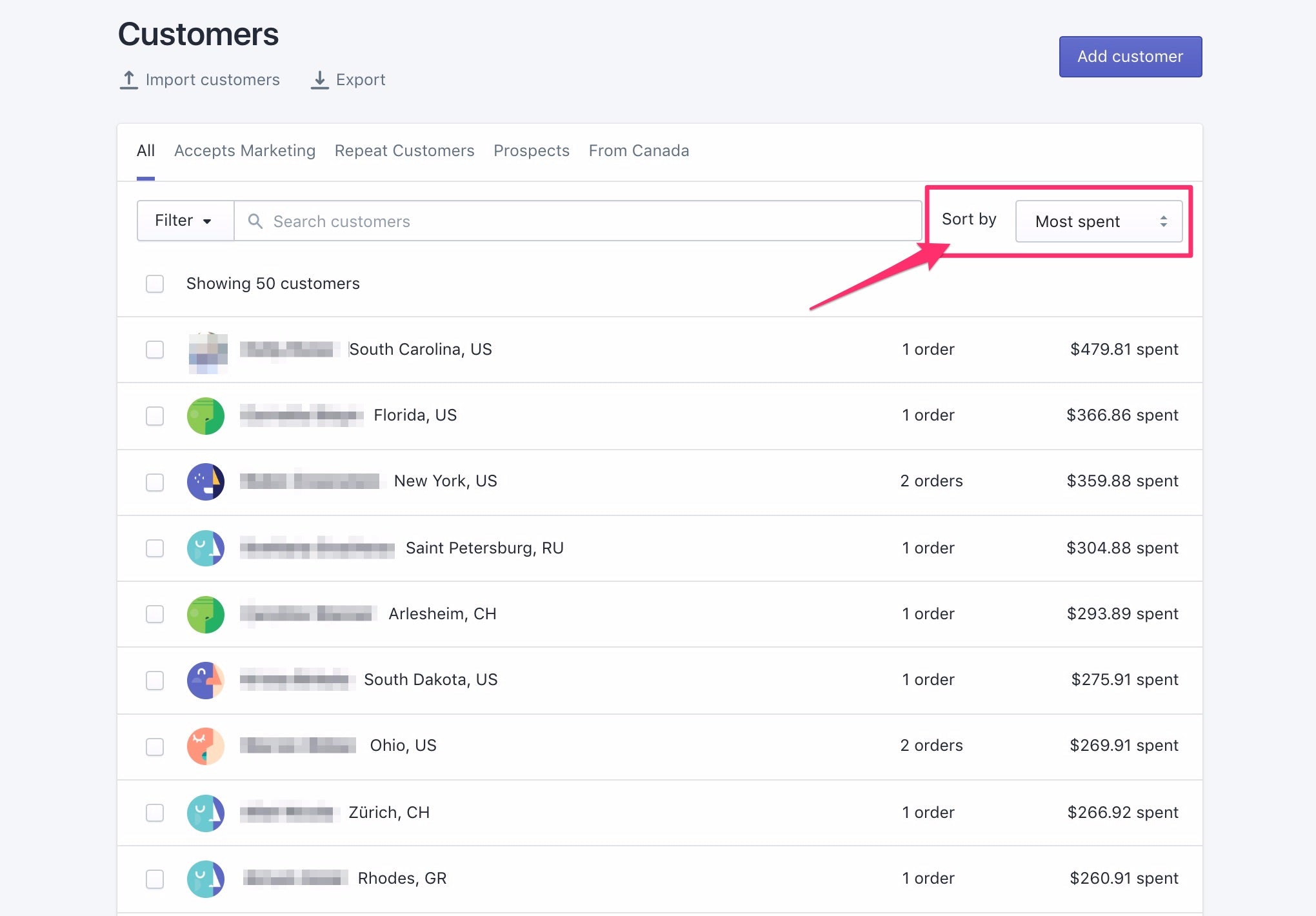
Essentially, this is your VIP customer segment. You know they love you, so reach out to them and ask for testimonials that explain why they’ve become such big supporters of your brand.
Reach out on social media to customers who’ve posted praise
Happy customers who’ve shared praise about your product on social media are already acting as brand evangelists for you, so you should spotlight these organic testimonials on your social channels, too.
Blankie Tails does this well by spotlighting positive testimonials on their social channels like Twitter, Facebook, and Instagram:

You can also take these efforts a step further. Consider reaching out to ask for a more formal testimonial from these happy customers that can live permanently on your site (without losing them to the fast-paced timeline of social media.)
Connect with “promoters” from a Net Promoter Score survey
Net Promoter Score surveys help merchants gauge customer satisfaction and loyalty by asking customers the question:
"How likely is it that you would recommend our company/product/service to a friend or colleague?"
Respondents can answer using a rating system of 1 to 10, with 1 being highly unlikely and 10 being highly likely.
With this data, you can then reach out to your “Promoters” (who responded with 9 or 10) and ask them to write a testimonial that reiterates those positive feelings.
How do you do this? You can collect Net Promoter Score responses via email by integrating a tool like SurveyMonkey or Customer.guru (and you can even embed positive customer testimonials directly to your site).
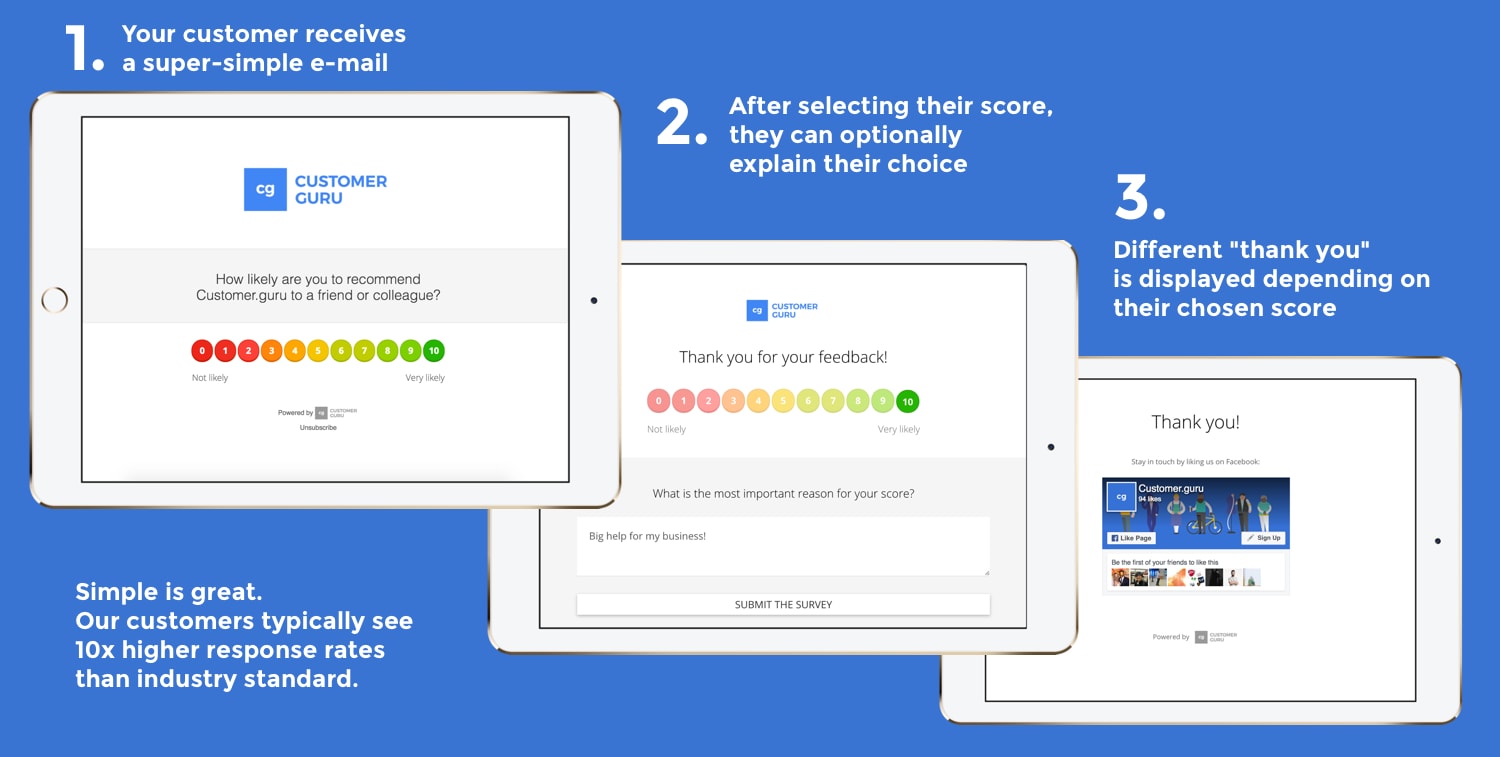
What to ask for in testimonials to set up home-run social proof
Now that you know where the ‘how’ and ‘who’ parts of testimonial collection, let’s get to the ‘what’.
It’s not enough to have general testimonials—you want solid, convincing testimonials that drive results for your business. In fact, data shows that customers spend 31% more with businesses that have good client testimonials.
So what makes a home-run testimonial?
In large part, specificity.
Generalizations aren’t very effective when it comes to social proof. Instead, you want highly descriptive recommendations and praise that touch on some of the pain points and obstacles to purchase your target audience is facing.
You can encourage your testimonial-givers to be more specific by:
- Reminding them of the product they bought from you. Keep the product fresh in the customer’s mind.
- Asking questions using words/language you want mirrored back in the testimonial. Include any key words and phrases your customers use when talking about the product.
- Showing them what other happy customers said about the product(s) they bought. Help inspire better quality testimonials by showcasing some contextual examples.
- Spelling out what you’re looking for in a testimonial. Do you need short-form soundbites? A few sentences? Stories? Be specific about what you want format-wise.
- Asking for supporting materials. Adding a photo of the person giving the testimonial boosts trust according to research on the concept of ‘truthiness’, while media like product photos/videos are valuable user-generated content that can enrich testimonials
- Asking them to address common customer doubts (reverse testimonials). Use questions like, "What were your concerns about buying (and how did you overcome them?)"
Learn from the best
Skincare company FloriVera is a company that gets highly specific testimonials from happy customers. Take a look at this testimonial one buyer left about their firming face oil:

Where to spotlight testimonials
Once you’ve started gathering testimonials, there are a few different places you should spotlight them to make sure you’re using them to their fullest potential.
Product pages (for product-specific testimonials)
Testimonials, ratings, and reviews are important to spotlight on product pages, as they give browsing shoppers an opportunity to read real feedback from past buyers. Bensly features a drop-down option with star ratings and customer reviews on every product page, as seen here:
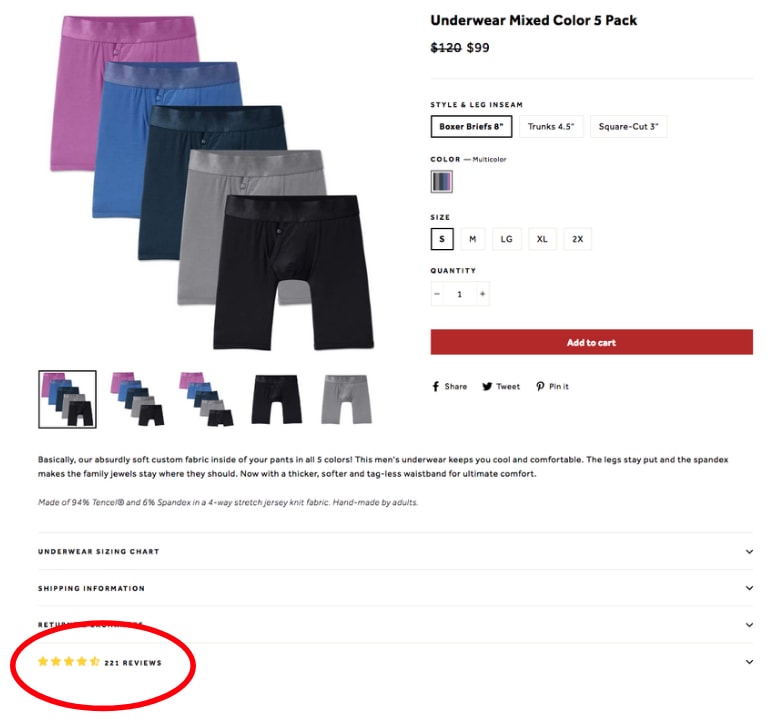
Social media
Every day, happy customers post hundreds of testimonials on social media without even being asked (or realizing that’s what they’re doing.)
By keeping track of your mentions, monitoring keywords around your products, and watching hashtags that include your company/product names, you can easily spot these testimonials in the wild, and then share them with the click of a button. This might be the easiest form of testimonial-gathering there is.
The Bearded Bastard does a great job of this on Twitter:

Testimonial page
Brands like Lotus Belle have a whole page dedicated to testimonials. They’ve taken an interesting approach by grouping types of testimonials by buyer concerns (wind durability, quality, size, etc.) as well as by celebrity praise and corporate feedback.
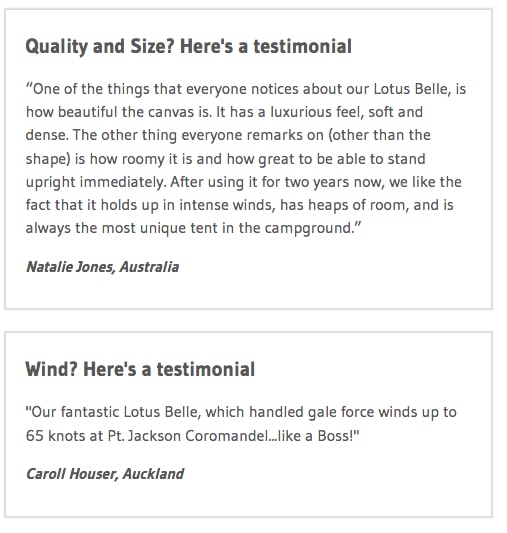
Built into in-depth case studies
You can even take testimonials a bit further by building them out into robust case studies that tell a story about problems your product solves.
Squatty Potty does this with a page devoted to medical case studies that prove the effectiveness of their solution:

Not only does this further validate your product for the customer, but it allows them to see a more robust form of social proof and take a deep dive into results produced and problems solved.
Should you outsource/automate testimonial collection?
At this point, you know the value of testimonials. You likely even have a rough strategy on how you’ll start integrating them into your business.
But then you stop and think, “Wait, do I really have time to do this?”
Collecting great testimonials does take some time, so it’s important to consider your options when coming up with a plan for execution. Every ecommerce retailer has a unique set of needs and resources, so take the time to decide which path is the best, most realistic option for your business.
First, let’s look at a few of the pros and cons around outsourcing or automating testimonial collection.
Pros
- Helps alleviate this task for your team if they’re already stretched too thin
- Allows you to gather/share a lot of testimonials quickly
- Lets you tap into specific testimonial-gathering expertise
Cons
- Might miss out on rich customer data if proper notes/call recordings aren’t done
- Quality control is out of your hands
- Missed opportunity for direct customer interaction
As with anything, there are both upsides and downsides to outsourcing. The deciding factor ultimately comes down to what will be the best route for your business. But let’s talk about options for outsourcing testimonials if you decide that’s what you’ll need to do.
Software solutions
There are lots of tools to consider when it comes to testimonial collection. Let’s look at a few.
KudoBuzz: This free app allows you to collect and display customer reviews and testimonials from social channels as well as Yelp and Google+. It also allows you to automatically send emails after order fulfillment to request feedback and can help you improve your SEO.
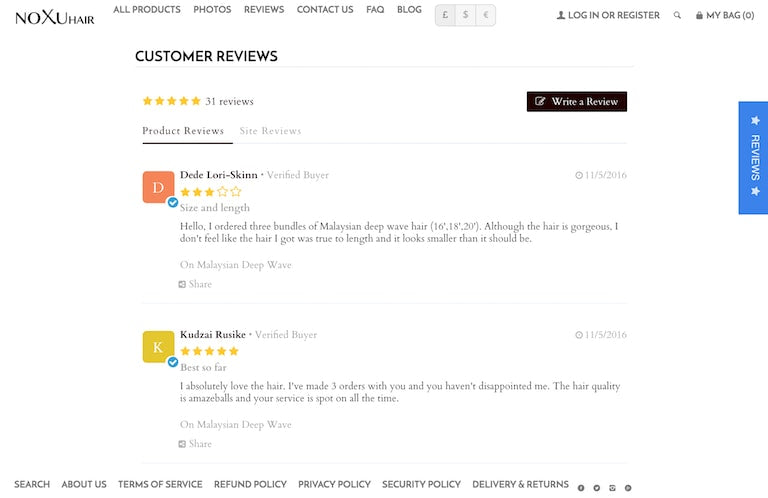
EVM Testimonials: Trusted by more than 600 Shopify users, this tool is $6/mo and allows you to collect (and moderate) rich customer testimonials with photos. Also SEO-friendly, this tool has advanced sorting features and fully customizable features so that your social proof flows nicely with the rest of your site.

Simple Testimonials: This no-frills resource allows you to collect and moderate customer testimonials on your site for $6.99/month. It’s mobile-friendly, beautifully designed, and integrates seamlessly with Shopify stores.
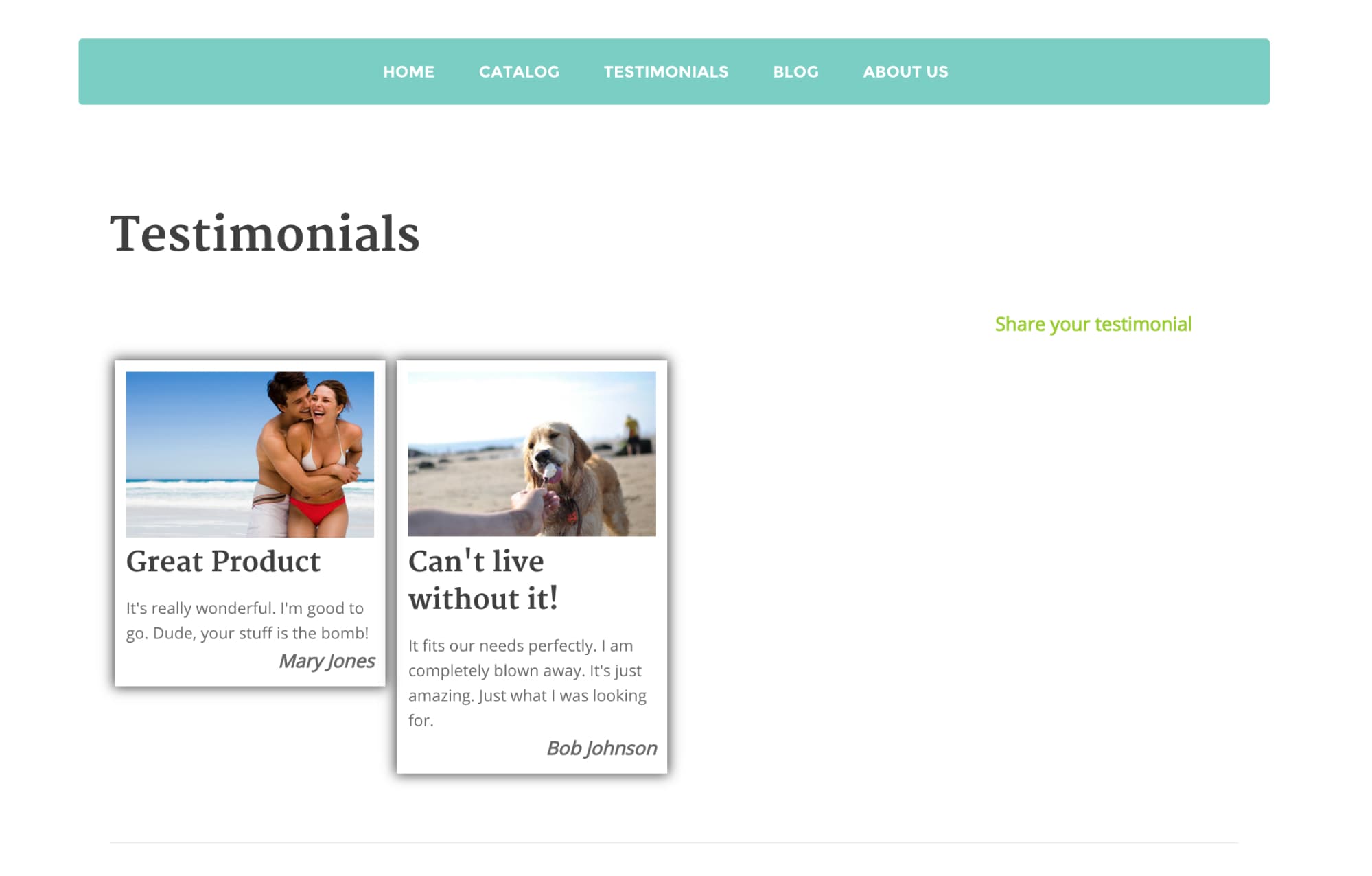
Freelancers/Agencies
Need an expert to take this off your hands completely? Consider outsourcing and connecting with a Shopify Expert who can help manage your testimonial collection all on their own.
Testimonials: Harness the voice of your customers
The big takeaway here is that most ecommerce businesses can benefit from investing some time into a testimonial collection process.
Whether you decide to use a tool to automate the process, outsource the work to an expert, or tackle testimonial collection on your own, find a way to unearth and surface positive sentiment from past customers. It can be a powerful way to win over new customers.